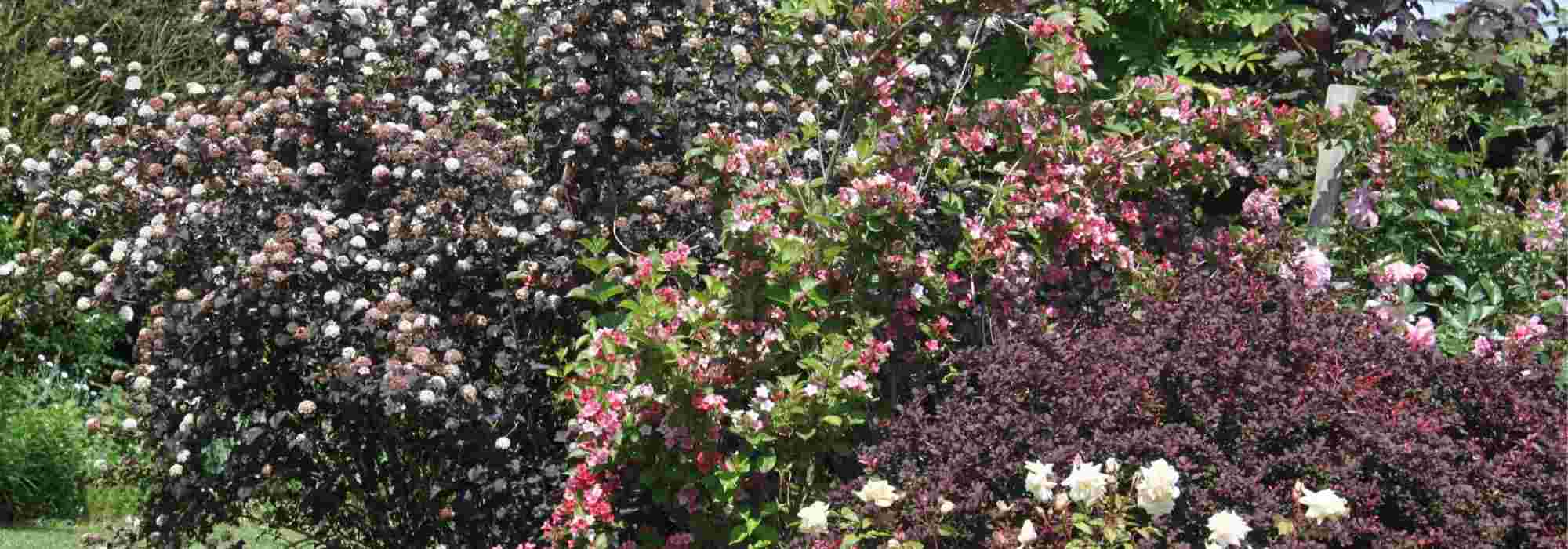
Physocarpus: 5 ideas to combine it in the garden
For hedges or borders
Contents
Physocarpus or Ninebark with obier leaves is a superb deciduous bush, decorative all year round because of its flowering in corymbs of white or slightly pink flowers from May to July, followed by small decorative red berries through to autumn, its bark that peels in winter and above all for its remarkably colourful and changing foliage! In spring it dons dense growth with dazzlingly vivid colours, quite extraordinary depending on variety, ranging from coppery purple or almost black in Physocarpus opulifolius ‘Lady in Red’, ‘Diabolo’, ‘Midnight’, and ‘All Black®’, to bright golden yellow (‘Angel Gold’). Hardy and easy to grow, it is indispensable for adding light and colour to garden and for contrasting with bushes with pale or dark foliage. Add a beautiful touch of golden or purple light to your borders or informal hedgerows!
Discover how and which plants to pair with Physocarpus in your garden!
In an informal hedging
With its rustic charm, Physocarpus suits an informal hedge that requires little maintenance. Of bushy habit and fairly rapid growth, Physocarpus ‘Dart’s Gold’, or ‘Amber Jubilee’, with yellow foliage that turns colour in autumn will be perfect in a pretty medium-sized informal hedge (between 1.5 m and 2 m high) alongside spireas (Japanese spirea ‘Golden Princess’, Spirea arguta, Spirea x billardii), viburnums (‘Onondaga’, Viburnum carlesii ‘Chesapeake’, Viburnum carlesii ‘Aurora’ which flowers just before, or Viburnum x bodnantense), a Neillia (Neillia affinis) or pink false spirea and Euonymus alatus ‘Compactus’. You can pair them with dark foliage of Physocarpus opulifolius ‘Diable d’Or’ with copper-purple leaves and Sambucus nigra ‘Serenade’ with finely divided foliage in a beautiful purple colour. To create an even more country-style effect, pair it with serviceberry, Corylus avellana or common hazel and hawthorn.
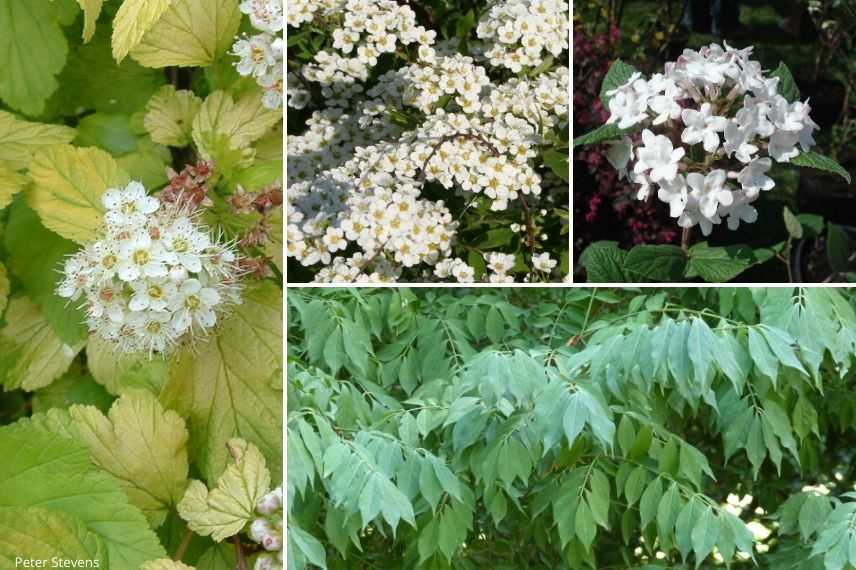
An example of an informal hedge combination: Physocarpus ‘Dart’s Gold’, Spirea arguta, Viburnum carlesii ‘Aurora’ and Euonymus alatus ‘Compactus’ with remarkable purple autumn foliage
To enlighten a shrub border
As Physocarpus foliage offers sumptuous shades of intense purplish-purple or golden green in spring depending on variety, magnificent in summer sunshine, and later takes on autumn hues, use it to brighten and enliven borders, whether in partial shade or in sun.
Physocarpus ‘Lady in Red’ will find its place in a bush border, to contrast with bushes with light foliage such as Cotinus coggygria ‘Golden Lady’ or Cotinus coggygria ‘Golden Spirit®’ with yellow‑orange foliage in spring then orange in autumn, or Acer palmatum ‘Summer Gold’. Weigela ‘Black and White’ with dark purplish‑green foliage will also be a good companion. They will catch the eye from spring! Purple varieties of Physocarpus are perfect for bringing out golden foliage of Euonymus japonicus ‘Aureovariegata’, Hakonechloa macra ‘All Gold’, Leycesteria formosa ‘Golden Lanterns’ (also called pheasant bush) or the silvery foliage of shrubby artemisias or dwarf willows (Salix subopposita and lanata).
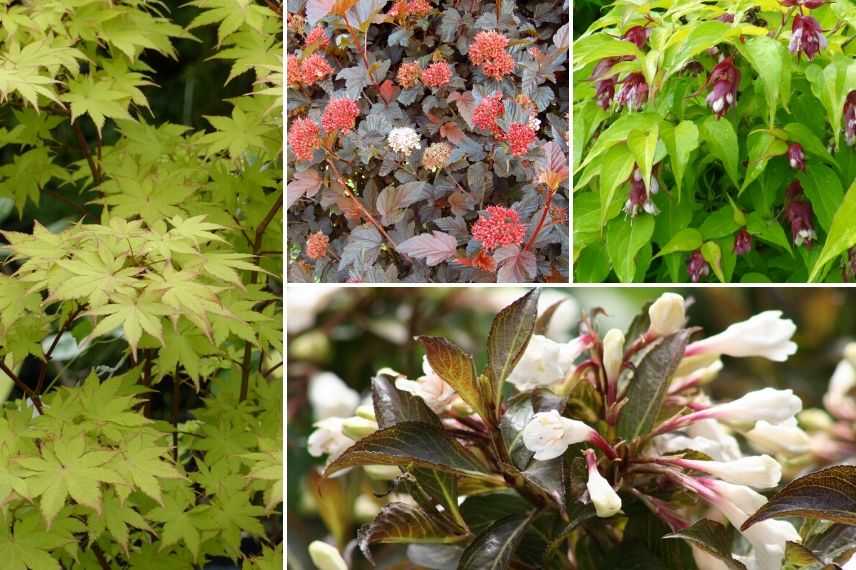
An example of an association in a border with other bushes: Acer palmatum ‘Summer Gold’, Physocarpus ‘Lady in Red’, Leycesteria formosa ‘Golden Lanterns’ with summer flowering and producing berries enjoyed by birds, and Weigela ‘Black and White’
Meanwhile Physocarpus ‘Angel Gold’ with coppery‑yellow foliage gradually becoming golden yellow at ripeness and Anny’s Gold® with variegated foliage will find their place in bush borders, in contrast with bushes with red or dark foliage such as purple or orange‑purple Berberis (Berberis thunbergii ‘Admiration’), Corylus maxima ‘Purpurea’, elder ‘Black Lace’ or Physocarpus ‘Midnight’ or ‘All Black’. Their fabulous autumn colours combine perfectly with late‑flowering bushes in shades of pink, such as Cotinus Royal Purple.
Discover other Physocarpus
View all →Available in 0 sizes
Available in 3 sizes
Available in 1 sizes
Available in 1 sizes
Available in 4 sizes
Available in 2 sizes
Available in 2 sizes
Available in 2 sizes
Available in 1 sizes
Available in 1 sizes
With perennials
Within a border of strong contrasts or in purple harmonies, to accompany the changing colours of Physocarpus (Physocarpus opulifolius ‘Diabolo’, ‘Lady in Red’ with red highlights), you can plant perennials at its base such as Heuchera ‘Blackout’ with almost black-brown foliage or Heuchera ‘Plum Royale’ or Heucherella, or giant autumn asters with mauve flowering (Aster laevis, Aster novae-angliae ‘Barr’s Pink’…). A Ceratostigma plumbaginoides, a magnificent groundcover with small, intensely gentian-blue flowers in summer and autumn will form a very pleasing contrast, as will hardy geranium phaeum ‘Lily Lovell’ with pure violet flowers and green foliage maculate with purple, and Heucherella ‘Solar Power’, with golden foliage marbled with brown.
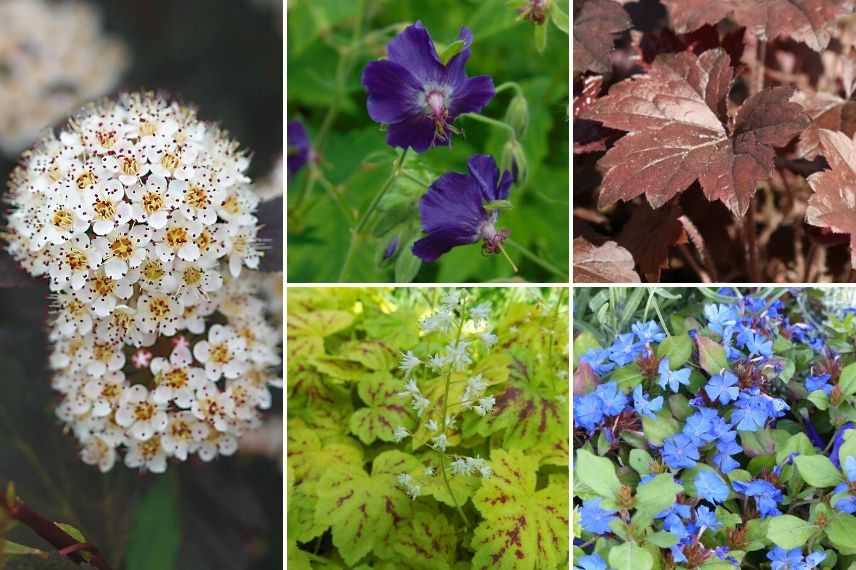
An example of a planting combination with perennials: Physocarpus ‘Diabolo’, Geranium phaeum ‘Lily Lovell’, Heuchera ‘Blackout’, Heucherella ‘Solar Power’ and Ceratostigma plumbaginoides
In a purple and aniseed-green scene
Physocarpus are very interesting for adding contrast in a fanciful border. Halfway between yellow and green, chartreuse is the perfect complementary colour to combine with purple foliage. For a combination that is at once contrasting, soft and harmonious, plant varieties of Physocarpus with exceptionally dark foliage, such as the Physocarpus opulifolius ‘Midnight’, a Quercus robur Purpurescens, a Sambucus nigra ‘Black beauty Gerda’, Cotinus in the background because purple adds depth. Punctuate with chartreuse-coloured perennials to bring rhythm such as golden sedge, a Dicentra ‘White Gold®’ with golden foliage, Heucherella ‘Stoplight’, Heuchera ‘Lime Rickey’, Lysimachia nummularia ‘Aurea’ and bushes with green leaves such as Berberis thunbergii ‘Tiny Gold’, a Physocarpus opulifolius ‘Angel Gold’ or a willow ‘Golden Sunshine’. In a flowering border, pair them with Allium bulbs ‘Globemaster’ or ‘Christophii’.
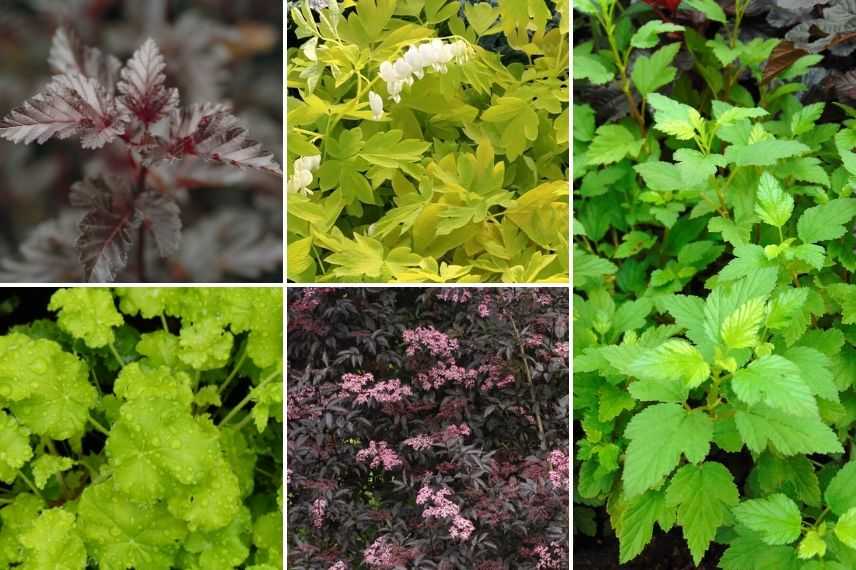
An example of purple and chartreuse combination: Physocarpus ‘Midnight’, Dicentra spectabilis ‘White Gold’, Heuchera ‘Lime Rickey’, Sambucus ‘Black Beauty’ and Physocarpus ‘Tiny Wine Gold’ (or ‘Dart’s Gold’)
In a planter on a terrace
Small varieties of Physocarpus with compact shapes and spectacular colours grow very well in pots on a terrace or balcony, such as Physocarpus opulifolius ‘Little Devil’. Plant them in large containers so they can develop well. They are fairly undemanding. Add colour at the base with a few small perennials such as heucheras, hardy geraniums or small ornamental-leaved grasses, such as Ophiopogon planiscapus.
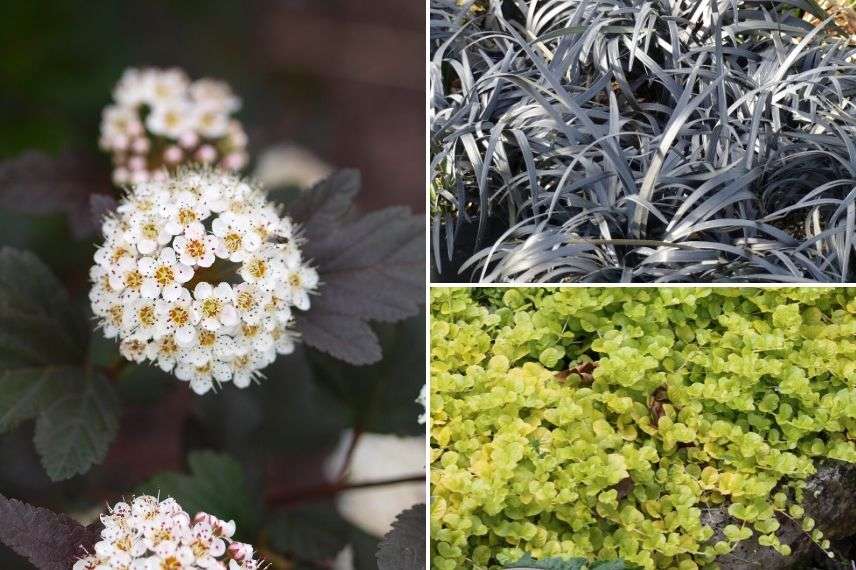
An example of a container combination: Physocarpus ‘Little Devil’, Ophiopogon planiscarpus, Lysimachia nummularia ‘Aurea’
- To learn everything about this bush and how to succeed with it in the garden, discover our advice sheet: “Physocarpus, obier-leaved physocarpus – Planting, pruning and care”
- Discover our wide range of Physocarpus
- Subscribe!
- Contents
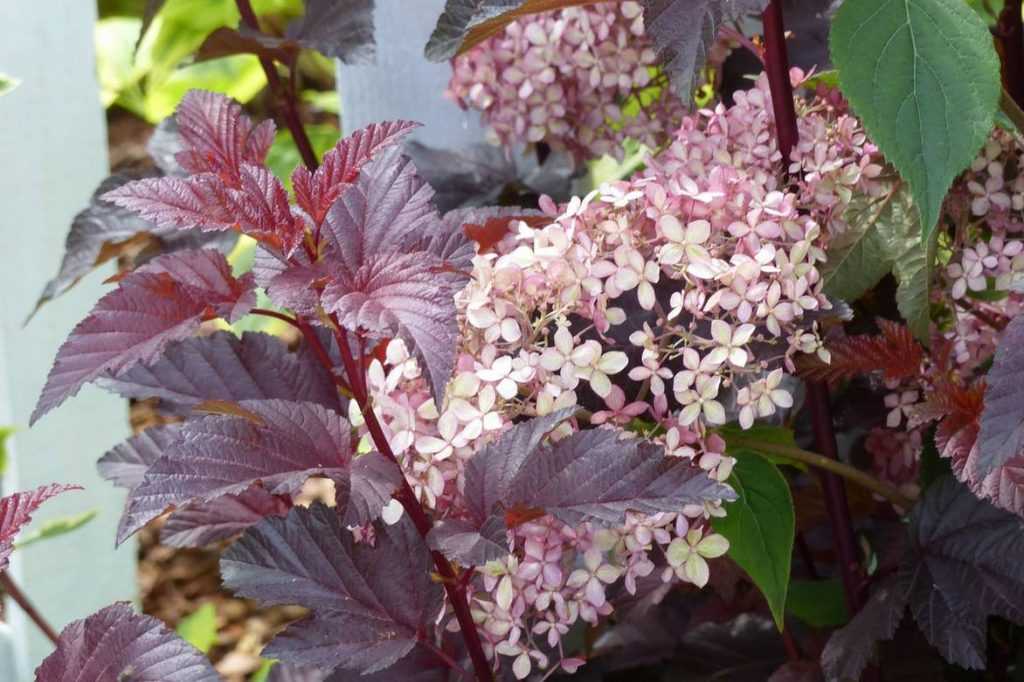































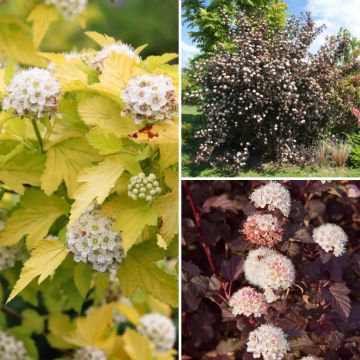
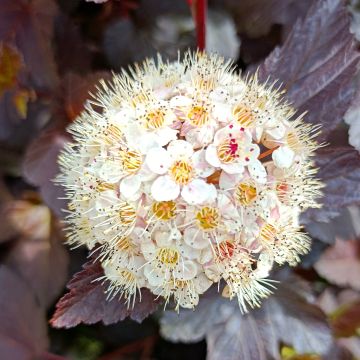
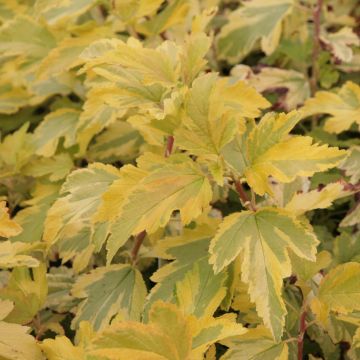
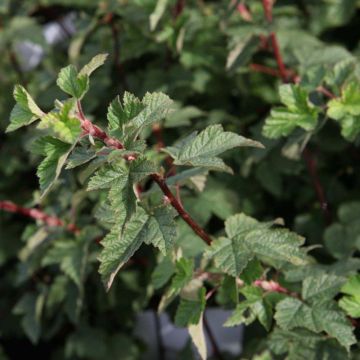
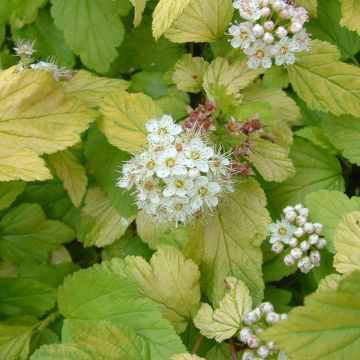
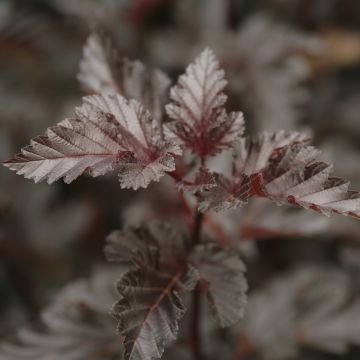
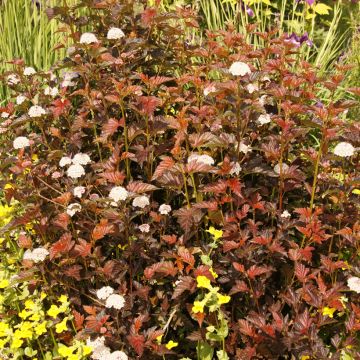
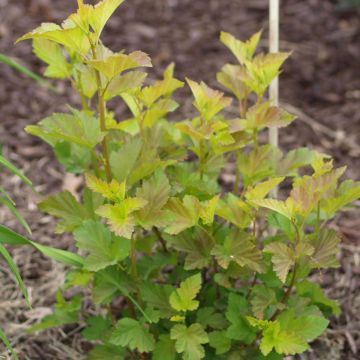
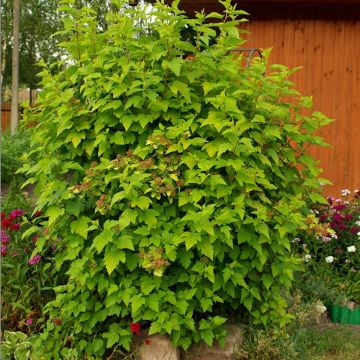
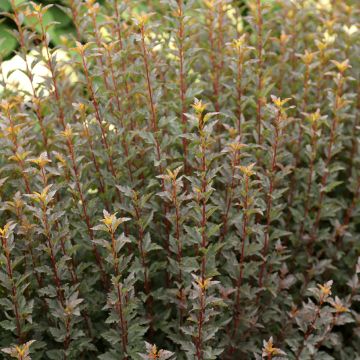
Comments